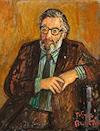Estorick Collection
‘The most civilised way to spend an hour in north London’
Estorick Collection, Canonbury Square, Islington

Elihu Estorick was born in Brooklyn in 1913 to Jewish parents who had exiled themselves from anti-semitic Russia. His father made a small fortune from inventing a machine that printed perfect colour samples. As a young man, Elihu switched to calling himself Eric, became a sociologist and political scientist and wrote several books, including two biographies of the British politician Stafford Cripps and a privately printed history of Marks & Spencer. He visited London often and made the city his permanent home shortly after the Second World War.
Eric and Salome Estorick (née Dessau) started collecting art on their honeymoon in 1948. In that time of austerity they bought hundreds of paintings and drawings at knock-down prices from all over Europe, especially avant-garde and experimentalist work from Italy and from the USSR and other Iron Curtain countries. Eric also signed an agreement with the Soviet government to act as an official export agent for modern Russian artworks.
Within a few years the Estoricks had put together an outstanding collection that was exhibited first at regional British galleries, then in 1956 at the Tate, and which afterwards toured Europe and the United States.

Eric Estorick (shown left in a painting by Arbit Blatas) was very much a dealer as well as a collector, selling some of the art he’d acquired and also buying at auctions on behalf of Hollywood clients who included Lauren Bacall, Burt Lancaster and Billy Wilder.
He profited handsomely from acting as exclusive world agent for the illustrator and fashion designer Erté, whom he met in Paris in 1967. Their partnership thrived for 20 years.
Six months before his death on Christmas Day 1993 he established the Estorick Foundation, to which he donated all his Italian works of art. The foundation purchased Northampton Lodge, a three-storey detached property in Canonbury built c.1820. The house was refurbished and adapted to serve as a gallery with a substantial grant from the Heritage Lottery Fund.
The collection is almost entirely devoted to Italian art from the first half of the 20th century, mostly from the Futurist school – a primarily Italian movement inspired by speed, technology and modernity. The paintings and drawings are displayed in six rooms, one or two of which are often given over to a temporary show, such as the photographic exhibition shown in the image below.
The Estorick Collection’s library has a significant and growing collection of books, periodicals and catalogues relating to 20th-century Italian art and is open to members of the public by appointment. There’s also a gallery shop and a licensed Italian café with outdoor seating in the back garden. Rooms are also available to hire if you’re looking to lay on a classy function.


